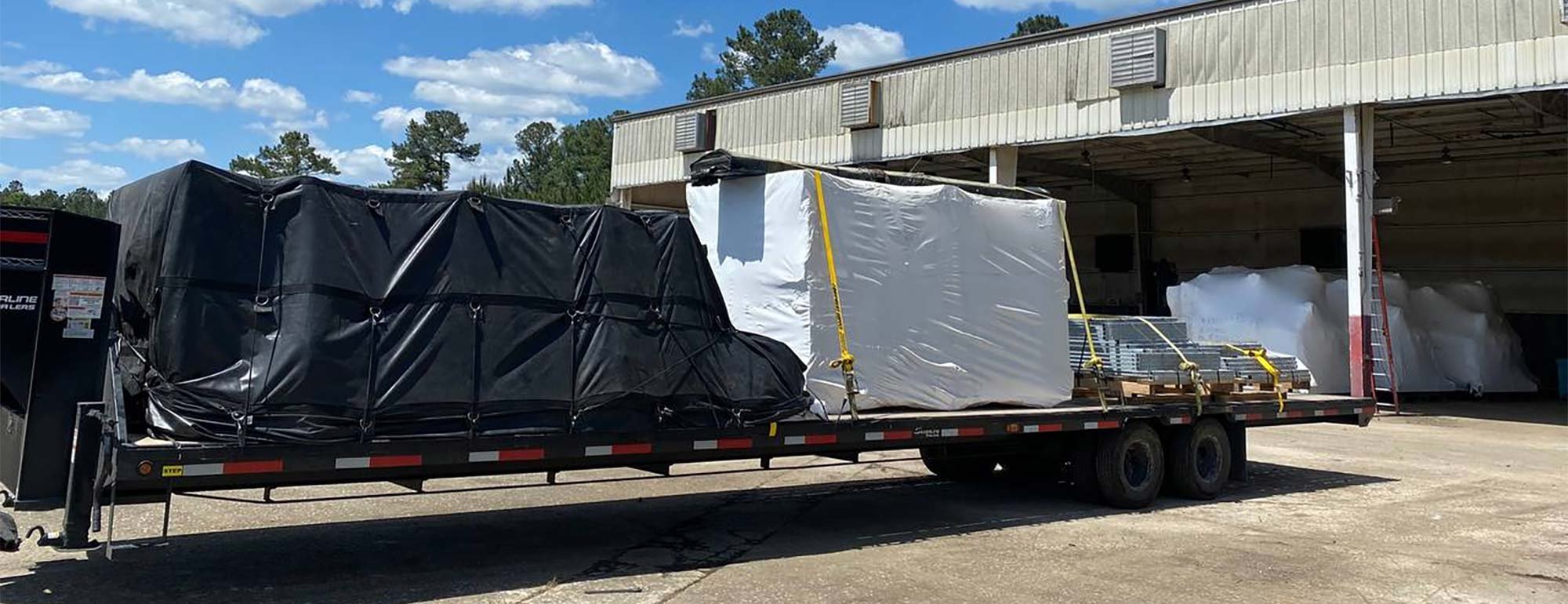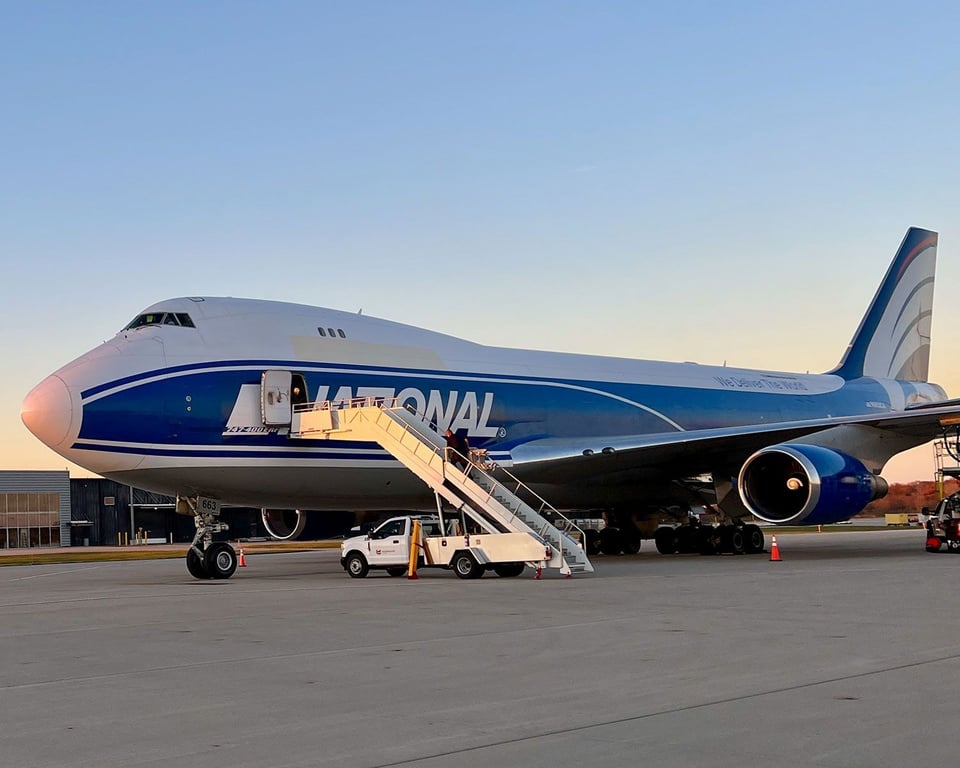Flatbed trucking plays a pivotal role in modern logistics, which is why you see so many open-deck trailers on highways today. Unlike enclosed vans, flatbed trucks have no walls or roof, enabling them to haul oversized and unconventional freight that keeps supply chains agile. From construction beams to heavy machinery, flatbeds provide the flexibility to load cargo from any side and deliver to locations without loading docks.
WHAT IS FLATBED TRUCKING?
TALK TO AN EXPEDITOR NOW
Get a Quote in Minutes for Your Time-Critical Freight Needs

What “Flatbed” Really Means
- Standard flatbeds are typically 48–53 feet long and 8.5 feet wide, with a deck about five feet high that can haul roughly 48,000–52,000 lb and freight up to 8 ft 6 in tall before over-height permits are required. Step-deck (drop-deck) trailers have a higher front deck and a lower main deck—around 3 ft 6 in high—so taller loads (up to about 10 ft) ride without permits.
- Double-drop (lowboy) trailers contain a very low middle “well,” offering clearance for loads roughly 11–12 ft tall, though they carry less weight.
- RGNs (removable goosenecks) detach at the front, forming a ramp so vehicles can be driven on. With additional axles or extendable sections, RGNs can handle extreme dimensions and weights.
- Many carriers also operate extendable flatbeds for extra-long freight and Conestoga (curtainside) trailers that combine open-deck loading flexibility with the protection of a retractable tarping system. A diversified trailer mix lets carriers serve everything from standard pallet freight to super-heavy industrial equipment.
How Flatbed Trucking Companies Operate
Fleet Assets & Trailer Mix
Leading flatbed carriers maintain a versatile fleet: standard flatbeds for general freight, multi-axle lowboys for heavy haul, Conestoga trailers for protected loads, and extendable flats for long commodities like wind-turbine blades. Lightweight aluminum–steel hybrid designs maximize payload, and optional accessories—bulkheads, Moffett forklift kits—serve niche needs. The right trailer, deployed at the right time, allows carriers to accept a wide spectrum of loads and avoid turning away business.
Dispatch & Load-Planning Workflow
A load begins with a shipper’s tender describing dimensions, weight, origin, destination, and special requirements. Dispatchers match the load to available equipment and drivers using transportation-management software and digital load boards. They arrange permits and escorts for oversize moves, ensure securement gear is on the truck, and provide drivers with detailed instructions. During transit, GPS and telematics supply real-time visibility, keeping shippers updated and allowing operations staff to manage exceptions quickly.
Regulatory Compliance & Safety Culture
Carriers must comply with Hours-of-Service rules, weight limits, equipment inspections, and cargo-securement standards. Electronic Logging Devices automate HOS tracking and contribute to reduced accident rates. A strong safety culture includes ongoing driver training, proactive equipment maintenance, and continuous monitoring of CSA safety scores. Shippers favor carriers with documented safety programs, low claims ratios, and transparent compliance records.
Technology & 2025-Era Innovations
Smart-trailer systems now monitor tire pressure, brake status, and load distribution remotely. Aluminum-steel hybrid frames cut tare weight, while mechanized tarping reduces driver injuries. AI-driven freight-matching platforms pair loads with nearby capacity, trimming empty miles. Route-optimization tools incorporate bridge-height limits and permit constraints for oversize freight, and carriers are piloting alternative-fuel tractors to meet sustainability goals.
Pricing Models
Most flatbed quotes follow a rate-per-mile plus fuel surcharge. Accessorial fees—tarps, multi-stop charges, detention, escort vehicles, permits—are itemized. For complex projects, carriers may offer fixed project pricing or dedicated daily rates. Transparent quotes detail the base line-haul, current fuel index, and expected extras so shippers can budget accurately and avoid surprises.
Common Flatbed Cargo Types
Flatbed capacity is prized for its ability to move freight that won’t fit inside a van or container. From raw materials that feed the construction boom to turnkey industrial assets worth millions of dollars, the open-deck trailer is often the only practical over-the-road option. Because these loads are exposed to the elements and secured in plain sight, shippers and carriers must coordinate carefully on tie-down methods, weight distribution, and—where necessary—oversize permits.
Structural Steel and Lumber
Heavy Machinery
Oversized modules and prefabricated structures
Bulk and miscellaneous freight
Industries That Use Flatbed Trucking
Leading flatbed carriers maintain a versatile fleet: standard flatbeds for general freight, multi-axle lowboys for heavy haul, Conestoga trailers for protected loads, and extendable flats for long commodities like wind-turbine blades. Lightweight aluminum–steel hybrid designs maximize payload, and optional accessories—bulkheads, Moffett forklift kits—serve niche needs. The right trailer, deployed at the right time, allows carriers to accept a wide spectrum of loads and avoid turning away business.

Manufacturing & Heavy Machinery
Manufacturers routinely ship industrial machines, presses, injection-molding units, and other capital equipment that dwarf standard van capacity in both weight and dimensions. Flatbeds (often step-decks or RGNs) allow factories to load these assets with overhead cranes or roll them aboard via detachable ramps, eliminating the need for costly disassembly.
Because these machines can be mission-critical at the destination plant, shippers value carriers with low claims ratios, ample insurance, and the know-how to block and brace high-value freight properly. Demand in this niche is relatively steady year-round, but spikes occur when factories upgrade production lines or when entire plants relocate, generating project-based surges that require dedicated flatbed capacity and tight coordination among riggers, millwrights, and carriers.

Energy (Oil, Gas, and Renewables)
From drilling rigs and coil tubing to oversized pressure vessels and wind-tower components, the energy sector depends on flatbeds for both routine supplies and monumental project cargo. Oil-field equipment often moves to remote pads accessible only by unimproved roads, while renewable-energy components—especially turbine blades and tower sections—require multi-axle or extendable trailers and detailed route surveys.
Activity in this vertical is inherently cyclical: oil and gas drilling programs surge or taper with commodity prices, and renewable-energy builds follow tax-credit deadlines and utility procurement cycles. Flatbed carriers that serve the energy market therefore maintain flexible fleets—step-decks, double-drops, RGNs—and strong permitting expertise so they can pivot from daily well-site resupply to moving a 200-ft blade across several states with escort vehicles in tow.

Construction & Infrastructure
Construction sites consume a constant stream of large, bulky materials—steel beams, rebar, lumber, scaffolding, concrete forms, and pre-cast bridge sections—that simply cannot fit inside dry vans. Flatbed trailers accommodate these items, allowing cranes or forklifts to drop loads directly onto the deck and enabling delivery straight to a job site that may lack loading docks.
Seasonal demand peaks in spring and summer when weather conditions favor building activity, so carpenters, project managers, and suppliers all rely on carriers that can scale capacity quickly. Because delays in material delivery can stall entire projects, contractors favor flatbed fleets with strong on-time records, specialized securement gear, and the ability to supply extendable or Conestoga trailers when weather protection or extra length is required.

Agriculture & Forestry
Agricultural producers and equipment dealers rely on flatbeds to move tractors, combines, balers, irrigation pipe, and fertilizer tanks—equipment that must reach farms on strict planting or harvest schedules. Forestry operations likewise depend on open-deck trailers to haul timber, sawmill machinery, and bundled lumber from remote logging sites to processors or export terminals.
Seasonality aligns with crop cycles: demand peaks during spring planting and fall harvest, when field machinery needs to be repositioned rapidly. Carriers serving this market must be adept at navigating rural roads, securing irregularly shaped loads, and timing deliveries to avoid muddy fields or off-road bottlenecks. Short-haul efficiency is particularly valuable here, as many moves are regional and require multiple daily stops.

Defense & Aerospace
Military agencies and prime contractors ship armored vehicles, missile batteries, satellite housings, and oversized aircraft parts—all of which exceed van dimensions and demand specialized securement. Flatbed carriers moving defense freight must hold the proper security clearances, maintain impeccable safety scores, and often comply with classified routing or blackout procedures.
Aerospace manufacturers likewise use flatbeds for fuselage sections, wing assemblies, and rocket components that are too large for rail or air transport. Although volumes fluctuate with program cycles, the loads are high-value and time-sensitive, making reliability paramount. Carriers that invest in air-ride trailers, low-deck heights, and real-time tracking technology position themselves as preferred partners in this tightly regulated, precision-driven sector.

Our Process lorem ipsum dolor sit amet, consectetur adipiscing elit. Nunc vulputate libero et velit interdum, ac aliquet odio mattis.
Value prop lorem ipsum
Ut posuere hendrerit nisl metus neque. Facilisis quis adipiscing a molestie. Tempor turpis tincidunt nulla diam in. Nec etiam ut neque placerat mauris nulla. Semper hendrerit at urna orci in faucibus sit lacus. Tincidunt fermentum consequat.
SEE OTHER CITIES WE SERVICE IN THIS STATE
Value prop lorem ipsum
Ut posuere hendrerit nisl metus neque. Facilisis quis adipiscing a molestie. Tempor turpis tincidunt nulla diam in. Nec etiam ut neque placerat mauris nulla. Semper hendrerit at urna orci in faucibus sit lacus. Tincidunt fermentum consequat.
SEE OTHER CITIES WE SERVICE IN THIS STATE
How to Find a Good Flatbed Trucking Company
- Clarify Your Transportation Profile
- Verify Compliance & Insurance
- Inspect Equipment & Securement Practices
- Check Coverage & Network Density
- Evaluate Service Performance
- Analyze Pricing Transparency
Clarify Your Transportation Profile
Measure your freight’s dimensions, weight, and special handling needs, then map out the lanes, volumes, and service windows you expect. Knowing these details up front lets you target carriers with the right trailer mix and geographic coverage.
Verify Compliance & Insurance
Confirm the carrier’s DOT operating authority and review its CSA safety scores to ensure a solid regulatory standing. Ask for a current certificate of insurance that shows at least $1 million in liability and cargo coverage equal to, or greater than, your shipment’s value.
Inspect Equipment & Securement Practices
Request photos or a yard visit to check trailer age, tire condition, and the availability of straps, chains, edge protectors, and tarps. Well-maintained equipment and ample securement gear signal lower risk of breakdowns or cargo damage.
Check Coverage & Network Density
Ensure the carrier runs consistent capacity in your origin and destination regions and can flex for seasonal spikes. A network that matches your lane structure reduces empty miles and supports stable pricing.
Evaluate Service Performance
Ask for on-time pickup and delivery statistics, claims ratios, and driver turnover rates. Carriers that track and share these KPIs tend to be disciplined, service-oriented partners.
Analyze Pricing Transparency
Study a sample quote to see the line-haul rate, fuel-surcharge formula, and accessorial fees—especially tarping, detention, and escort charges. Clear, itemized pricing minimizes surprise invoices and makes apples-to-apples comparisons possible.
Dedicated Single Point of Contact
At the heart of HotShotTrucking.com is a dedicated team of professionals working tirelessly behind the scenes to ensure every shipment arrives on time, and in optimal condition, at its final destination. We offer the fastest ground and air transportation options for B2B customers across the United States, Mexico, and Canada. Get peace of mind with a dedicated single point of contact. We're with you along every mile of your journey.

Hi I'm Steve
Reach out today and let's solve your urgent shipping needs. I or a member of the team will be with you from start to finish. Let's chat
Frequently Asked Questions
What is flatbed trucking and how does it differ from other freight services?
Which types of cargo are most suitable for transport by flat bed trucks?
How do flatbed trucking companies secure loads safely for transit?
What regulations govern load dimensions and weight in flatbed freight?
How much does hot shot flatbed shipping typically cost compared with standard flatbed rates?
Because hot shot flatbed runs are expedited, same-day or next-day jobs, their per-mile rates are usually higher than those of scheduled line-haul lanes—often 15–35 percent more. Costs hinge on mileage deadhead, commodity value, difficulty of securement, and market demand. While you pay a premium, hot-shotting avoids plant shutdowns or construction delays that could dwarf transportation charges. Many shippers offset the price by bundling return freight or scheduling off-peak pickup windows when capacity is more plentiful.
What role do permits play when hauling oversize loads on a flatbed hotshot route?
How do professional drivers find reliable flatbed trucking loads?
What insurance coverage should shippers expect from the best flatbed trucking companies?
How can shippers minimize delays when booking flatbed truck freight during peak seasons?
Why are flatbed carriers popular for construction and energy sector projects?
Related Blog Posts

What is Hot Shot Trucking? aka HotShot Trucking
Modern business is all about strict timelines. Whether your field is manufacturing, extraction, retail, or research and development, your operations are bound to rely on a variety of activities that operate in tandem. The most minor of supply shortages can throw these activities off, potentially costing you thousands of dollars just for a few hours' delay. Success thus hinges on your ability to right the ship as quickly as possible after a...

Hot Shot Trucking for the Oil Industry
Hot shot trucking originated in the oil and gas industry. It was a response to the need for rapid transport of time-sensitive materials to remote drilling sites. Today, it plays a critical role in the logistics of the oil and gas sector. This article delves into the intricacies of hotshot trucking within the oil and gas industry. We'll explore how it provides fast freight and expedited shipping solutions, ensuring quick delivery of critical...

The History of Hot Shot Trucking in North America
Businesses facing shipping emergencies have long counted on hot shot trucking to fill the gaps. But the hotshot field didn’t just pop into existence as it is today. Rather, this bastion of emergency shipping developed slowly over time, emerging and expanding in tandem with the rest of the trucking industry. From the earliest days of pre-automotive transport to the modern era of brokers, reshoring, and JIT production systems, hot shot providers...

Advantages of Dedicated Freight Services
In the expedited freight industry, efficiency is paramount. Dedicated freight services offer a solution, promising speed, safety, and consistency. Dedicated freight services involve the allocation of specific vehicles, such as sprinter vans or tractor trailers, exclusively for a single client's cargo transport needs. Unlike traditional freight carriers, dedicated freight services provide tailored solutions that align with a client's unique...

The Types of Vehicles Used for Emergency Freight
When you're facing a shipping emergency, every minute counts. And you need more than just a truck – you need a solution. The right emergency freight choice ensures that your urgent cargo reaches its destination as quickly, safely, and cost-effectively as possible. Selecting the appropriate freight service depends on several key factors, including shipment size, distance, time constraints, and the nature of the cargo.

Understanding Full Truckload Services (FTL)
Full Truckload (FTL) services have solidified their place as a vital shipping solution for expedited freight. With the trucking industry powering over 70% of the nation’s freight, FTL stands out as a key service that helps to ensure supply chains operate seamlessly. But what drives the enduring value of FTL and why are industries using it? Whether you’re wrestling with freight costs or hunting for the best rates, learning about the capabilities...

Houston Hot Shot Delivery
Houston’s position as a national energy hub means urgent shipping needs are commonplace. When a critical piece of equipment fails in an oilfield or at a refinery, hot shot delivery services become a supply-chain lifeline for the Houston economy. Hot shot trucking is a niche but vital segment of the trucking industry, specializing in rapid, on-demand transport of smaller, time-sensitive freight loads. In a logistics hub like Houston hot shot...

Louisiana's Transportation Plan To Benefit Hot Shot Trucking Industry
After years of discussion and debate from countless stakeholders, Louisiana is starting a new infrastructure project. Governor John Bel Edwards unveiled a $600 million plan to improve the state’s highways. Focusing on widening Interstate 10, this plan will be a boon to Hot Shot Trucking and other transportation companies that traverse the state. Governor Edwards announced the plan on Friday, May 13th, claiming that it was “of the utmost...

747 Freighter Air Charter to Hawaii
When it comes to providing air cargo capabilities, there is no aircraft in the world that compares with the Boeing 747 series of freighters. All three 747-400F, 747-400ERF and 747-8F freighter models in service today, are unmatched in carrying capacity, cargo handling, global reach, speed and versatility. An aviation icon born in 1968, the 747 is instantly recognizable by its large upper deck “hump”, four engines and six-story high vertical...

How Highway Closure Impacts Hot Shot Trucking California
Natural disasters can disrupt any industry, but their impact is particularly serious for logistics companies. The recent mudslides in California are a powerful case in point. By blocking Highway 101, one of the Golden State’s most important roadways, this environmental crisis has diverted trucks from their usual routes. This has significantly increased the cost and difficulty of completing hot shot freight deliveries, hampering the economy of...

The Advantages of Hot Shot Trucking for Small Businesses
In the world of logistics, small businesses often face unique challenges when it comes to shipping their products efficiently and cost-effectively. This is where hot shot trucking can be a game-changer. Hot shot trucking offers a range of advantages that can significantly benefit small businesses, enabling them to compete in the marketplace and meet customer demands. In this blog post, we will explore the advantages of hot shot trucking for...

Essential Tips for Successful Hot Shot Trucking
Running a successful hot shot trucking business requires a combination of effective strategies, attention to detail, and a commitment to customer satisfaction. Whether you're a new entrant or an experienced hot shot trucker, adopting essential tips can help you navigate the industry and increase your chances of success. In this blog post, we will provide practical advice and strategies for running a thriving hot shot trucking business, covering...
WHAT IS HOT SHOT TRUCKING? AKA HOTSHOT TRUCKING
Modern business is all about strict timelines. Whether your field is manufacturing, extraction, retail, or research and development, your operations are bound to rely on activities that operate in tandem. The most minor of supply shortages can throw these activities off, potentially costing you thousands of dollars just for a few hours' delay. Success thus hinges on your ability to right the ship as quickly as possible after a supply shortage arises.
Industries We Serve
Modern day hot shot trucking provides the speed and exclusivity you need to meet the most demanding and time-sensitive shipping requirements. We use every resource, avenue, and channel available to ship your freight by ground or air. Designed specifically to address supply and distribution problems that arise without warning, hotshot trucking tactics involve coordinating a network of carriers in a variety of locations. By calling on the vehicles closest to your supply or distribution points, hotshot brokers can fill any sudden gaps in your supply network almost as soon as they happen. This minimizes the disruption to your business and allows you to quickly return to ordinary operations, weathering the storm without skipping a beat.
Automotive
The automotive supply chain already has significant challenges. Don’t let malfunctioning equipment stop the production line. Step on the gas with HotShotTrucking.com’s suite of services that will get you back in the fast lane. With HotShotTrucking.com, companies are devising shipping strategies to swiftly deliver critical parts and equipment — whether it's ground expedite service with sprinter vans, box trucks and 53-foot tractor trailers or air freight and air cargo.
Aviation & Aerospace
Every moment a commercial airliner sits on the ground, it costs an airline money. Expedited freight services by HotShotTrucking.com can get you back in the air with prompt delivery of parts and equipment throughout North America. We are equipped with the expertise to navigate the complexities of shipping jet engines and other types of loads, and our network of hot shot drivers has extensive experience transporting aviation assets.
Construction
One shipping delay can snowball and cause delays throughout your entire project. You need an experienced 3PL provider who understands the construction industry and has the logistical reach to deliver your freight on time, anywhere. That 3PL partner is HotShotTrucking.com. Whether in the air or on the ground via truck and trailer, we can connect companies to expedited freight services for the prompt delivery of parts and equipment throughout North America.
Mining & Metals
From cranes to chemicals to excavators to conveyor belts, HotShotTrucking.com has the experience and industry know-how required for shipping sensitive, oversized, and hazardous equipment. Third-party hot shot trucking and logistics providers such as HotShotTrucking.com specialize in devising and implementing innovative shipping solutions, ensuring mines can swiftly return to operation. We’ll pick up your shipment, deliver it to the airport and receive it at the other end – providing hand-carried service as necessary or required.
Manufacturing
Every moment a manufacturing facility or factory sits idle costs a company money because of the high costs involved. With many manufacturers building to only just-in-time production rates, any disruption threatens parts and vehicle inventories. This is where the speed and expertise of freight services from HotShotTrucking.com can make a difference throughout the entire manufacturing supply chain. We do all the logistical legwork to find the optimal solution for your job, whether it's an exclusive air charter or expedited ground shipping.
Telecommunications
From servers to cell towers, information, voice, and data must flow to keep businesses, production, and the public online and connected. When equipment goes dark, depend on HotShotTrucking.com to get your systems flashing green again. This is where the speed and experience of trucking and freight services from HotShotTrucking.com can help. Our hot shot truck network excels at the prompt delivery of parts and equipment throughout North America.
Oil & Gas
The oil and gas industry faces challenging conditions in offshore and onshore oil rigs, often in remote locations with limited infrastructure. Don’t let oil pumps or pipelines sit idle waiting for equipment. By having the right plans, parts, people, and logistics partner like HotShotTrucking.com, you can effectively mitigate plant or pump downtime, unscheduled disruptions, and equipment failures.
Cost of Urgent Shipping
Which of our specialized shipping services best fits your needs?
Blog and Resource Center
How AirFreight.com Solved a PGA Tour Shipping Emergency
Learn how AirFreight.com located a lost shipment and helped save the PGA Golf Tour.
How AirFreight.com Saved The Farm By Solving A Major Shipping Delay
Learn how we saved a Montana-based artisanal farm thousands of dollars by expediting a shipment of perishable goods.
Expedited Shipping Vendor Comparison
We’ve done the research for you. This vendor comparison sheet breaks down how AirFreight.com stacks up against the competition.

talk to an expeditor now
Get a Quote in Minutes for Your Time-Critical Freight Needs
GET A QUOTE
